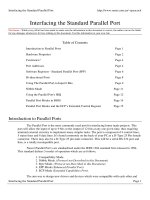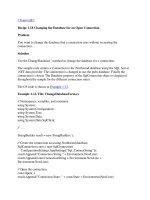Tài liệu Reprogramming the Mind for Success ppt
Bạn đang xem bản rút gọn của tài liệu. Xem và tải ngay bản đầy đủ của tài liệu tại đây (418.17 KB, 29 trang )
Reprogramming the Mind for
Success
This ebook is proudly brought to you by
Tamara Baruhovich
www.Abundance4me.net
You now have the rights to give away this special ebook as long as the links remain
untouched. For special branding options see the end of the ebook.
© Tridean Pty Ltd www.ReprogrammingtheMindforSuccess.com and Dean Whittingham
2008
Notice: This publication was designed to give accurate and informative information on
the subject matter involved. It is sold with the understanding that the publisher and
authors are not engaged in rendering medical, legal, accounting or other professional
services. If you require legal or financial advice, or other expert assistance, you should
consult with a licensed professional.
Reprogramming the Mind for Success: Become One of the Successful 10% by
Reprogramming Your Mind for Success
By Dean Whittingham
All Rights Reserved. This e-Book, or parts thereof, may not be published or reproduced
in any form without the express written permission of the publisher.
Second Edition: 2008
Table of Contents
Introduction.....................................................................................................4
Your Self-Image: Your Comfort Zone...........................................................5
The Subconscious and Association.................................................................8
The Reticular Formation...............................................................................10
The Psycho-Cybernetic Mechanism and the Amygdala...............................13
Our Comfort Zone ........................................................................................16
Case Study: The Lotto Winners....................................................................18
Their self worth in terms of wealth........................................................................23
Their self worth in terms of ability to create income.............................................24
Their self worth in terms of enjoying life..............................................................24
Review: The Trader.......................................................................................26
Re-Programming our Self-Image.....................................................................
Bombarding the Subconscious..........................................................................
Visualization..............................................................................................................
Affirmations...............................................................................................................
Meditation..................................................................................................................
Emotions...........................................................................................................
Conclusion.........................................................................................................
Tools..................................................................................................................
Audacity.....................................................................................................................
CDex..........................................................................................................................
Brain Wave Generator...............................................................................................
Desktop Subliminal Software....................................................................................
The Process of Reprogramming The Mind for Success....................................
Reprogramming the Mind for Success
Introduction
A decade ago, my parents won a lot of money playing lotto. Based on their income levels
at the time, it was enough money to see them right for the next 10 years, and this was not
including any interest they would have earned. However, in four short years after
winning the money, they were dead broke. They had gone from living in their own home
with a mortgage, a job each and a little left over money at the end of each month, to
bankruptcy and having to live in government housing. The whole ordeal split them apart.
It took six more long years before they were able to reunite.
Many responses (especially from close family) to this event were actually quite similar.
Although the initial shock was unsurprising, and the inevitable question of ‘how could
you waste away half a million dollars, and get into so much debt?’ was asked repeatedly,
the most disturbing response was ‘If I had won that money, there’s no way I would have
lost it all.’
I found that statement disturbing, but at the time, it was more because it felt like our
family and friends were quietly glad that everyone was back on a level playing field, and
none of our family members was financially well off. Later, it became more disturbing
because it became apparent to me that they were all wrong. Not one of them, had they
won that money instead, would have done things differently. They all would have ended
up the exact same way.
I found this out when reading an article written by a millionaire, that almost 90% of lotto
winners end up worse off than they were before they won the money, and they usually do
it in less than 5 years. Wow! Talk about a bolt of lightening. Why? Why is this statistic
true?
That is the question I sought to answer in this report. Why do the suddenly rich
invariably seem to end up right back where they started?
4
© 2008, Dean Whittingham
Reprogramming the Mind for Success
Your Self-Image: Your Comfort Zone
There is a famous story of a stock trader (I use this story because stock trading is
marketed and perceived as one of the easiest pursuits – when in fact it is just like
everything else) who, year in and year out, starts with about $10,000 and usually by the
end of the year has turned that $10,000 into a quarter of a million. However as soon as he
reaches this milestone, he immediately loses it back to the markets, and usually ends up
back where he started with $10,000. This is quite a disturbing occurrence, and we must
wonder what is going through this trader's mind.
This is the same thing that was going through
my parents’ minds even today, as they are not
much better off financially than 6 years ago.
In fact, they have gone full circle, to where
they were a few years before winning the
money. It is the same thing going through the
mind of someone who wants to lose weight,
but no matter what they try, they keep failing. It is the same thing going through the
mind of the person who just cannot seem to make a relationship work. This is all to do
with our self-image and the control centre, which functions within the subconscious.
As part of the subconscious, there are four systems in our brain that co-exist together and
affect our results in life; they are:
associations and neural pathways
the reticular formation
the psycho-cybernetic mechanism
and the amygdala.
I will explain the processes and functions of each system soon, however first I will give
you a general idea of what goes on in our decision making process.
5
© 2008, Dean Whittingham
Reprogramming the Mind for Success
Every person has a self-image of themselves embedded in their subconscious. This self-
image determines what decisions and actions they feel compelled to take. A person’s self-
image is in fact their comfort zone and belief system.
When we receive input through our five physical senses, at a rate of about 10-11 million
bits per second, our brain mechanisms assess the information to find a match to our self-
image and beliefs. If any of the information is not in line with out beliefs and self-image,
it is generally ignored. In fact, we do not even know we have processed it. We are only
aware of the bits of information that match our beliefs.
However, every now and then, we are forced to digest information that is not in line with
our beliefs or self-image, such as that of wanting to become a millionaire when the most
we have ever earned in a year is $50,000. Initially, when forced to digest this possibility,
the first process in our brain alerts us to the fact that it has received information not in
line with our beliefs. It proceeds to trigger feelings that we do not like, such as fear and
anxiety.
Briefly, when faced with something that we have never achieved or experienced before,
our brain goes into a slight shock therapy state, which tells us we are out of our comfort
zone, and it is time to get back in. The decision making process that follows will always
attempt to pull us back into this zone.
If we think of the trader mentioned earlier, in his first
year, he would not have had a self-image of someone
who was worth $250,000. His self-image was of
someone only worth $10,000. Subsequently, after
making his first $250,000, he immediately felt
uncomfortable and made decisions that pulled him
back into his comfort zone.
6
© 2008, Dean Whittingham
Reprogramming the Mind for Success
However, his self-image as a trader is more like someone who is confident with his
ability to trade. To turn $10,000 into $250,000 in 12 months is a great feat, so this was
not a matter of being a bad trader.
After a few years, the trader creates another self-image or belief, one of someone capable
of turning $10,000 into $250,000 in less than 12 months, but unable to keep it. His
actions, like self-sabotage, are reinforcing his belief that he is only worth $10,000. He is
also creating another belief – that he cannot hold on to $250,000. Either way, they are
both undesirable.
If his self-image is one of someone worth only $10,000, then its job is to ensure that this
remains the case in his physical world. The act of trading and turning his $10,000 into
$250,000 will get harder as time progresses, to the point where his beliefs finally get the
better of him.
7
© 2008, Dean Whittingham
Reprogramming the Mind for Success
The Subconscious and Association
Our mind is made of millions and millions of highways called Neural Pathways. These
neural pathways join parts of the brain that associate certain memories to stimulus to
form a picture or idea.
When you look at a basketball, there is an area of your brain that associates the image
with ‘round’, an area that associates it with ‘ball’, an area that associates it with ‘orange’
and so on. When you first learn that it is a ‘basketball,’ you create another association
with the word ‘basketball’. Neural pathways are created and strengthened by being used,
others weakened by not being used (except those that are genetically hard-wired through
evolution). So, the more you see these associations together (round orange ball), the more
these neural pathways are used and strengthen and the easier it is for your mind to
recognize the basketball.
Another way of explaining this phenomenon is to think
of a child. The child will probably learn to associate
with ‘orange’ on its own, before it knows what a
basketball is, and the same would be true for ‘ball’ and
‘round’. Over time, as these associations are triggered
more and more, the neural pathways that join these
associations strengthen and so does the child’s
understanding of a basketball.
Think of a piece of electrical wire. What would happen to a piece of electrical wire if you
kept wrapping it with electrical sticky tape? It would get thicker and stronger the more
you wrapped it. Your neural pathways do the same. The more they are fired to send
messages between associations, the stronger they become.
Over time, the more you act, think, and speak in a certain way, the more you strengthen
the very neural pathways that fire this behaviour, to the point where you can do it
8
© 2008, Dean Whittingham
Reprogramming the Mind for Success
unconsciously. This is the same as forming a habit. Habits are automatic behaviours that
occur due to very strong neural pathways.
Every second of our existence, our subconscious processes, facilitates and creates
between 10 billion-400 billion actions (neural transmissions). It also controls between
96-98% of our perception and behaviour. What was once thought a waste of space (i.e.
the myth that we only use a small amount of our brain) is in fact our control center and is
the most important part of us.
However, the subconscious has two flaws (depending on which way you look at it); it
cannot tell the difference between what is true and what is not, and its job in relation to
our conscious is to do exactly what it is told. Now I say that it depends on which way you
look at it because you do have a choice as to how to use it. This is where your conscious
comes in.
Put simply: your conscious mind has a job. Its job is to
tell the subconscious mind what to do. Your
subconscious mind also has a job, and its job is to do
what the conscious mind instructs it to do, regardless of
whether the instruction comes from conscious responses
to external stimulus, or to thoughts processed by the
imagination.
Your subconscious stores all of your associations such as memories, beliefs and habits
(which are 10,000 times more powerful than desires). It uses these to match information
from the outside world. It ignores any information that does not match. Let us see how
this is done.
9
© 2008, Dean Whittingham
Reprogramming the Mind for Success
The Reticular Formation
“The human mind has an ‘inhibitory system’ which routinely and automatically removes from
perception, reason, and judgment over 99% of available fact.” – Jerome S. Bruner
Inside our brain stem lies a formation about the size of our pinky finger, called the
reticular formation. This connects to other parts of the brain and our body via millions of
communication pathways. This whole system was named ‘The Reticular Activation
System (RAS)’ by physiologist H. W. Magoun, who discovered that by stimulating it,
you could wake someone from their sleep.
The RAS is the connection between anything and everything of our being. It receives
and sends all of the information within our body. Each of the 10-11 million external bits
of information we process every second goes through the RAS. The messages required
for our bodily functions and organs are fired from this system as well. It is the main
control center of our being.
Because our conscious mind cannot cope with so much information, our RAS serves as a
filter by eliminating what is not on our ‘priority list’. In fact, the reticular formation is
the only segment of the brain which has access to all incoming information, is known to
immediately scan and prioritize that information, select “appropriate” responses, and has
two-way communications with all of the subsystems.
For example, most mothers are able to hear the sound of their
baby crying while they are sleeping, even from the other end of
the house. Yet a siren going past at 5am, obviously making a far
louder noise, may not wake her. I actually witnessed this one
morning and could not believe the siren did not wake my wife.
However, 20 minutes later, she awoke to my daughter’s cry,
even though there was a significant difference in volume
between the two.
10
© 2008, Dean Whittingham
Reprogramming the Mind for Success
This does not just work with instincts; it also works with beliefs, habits and your self-
image. The Neural pathways that we create on a day-by-day basis actually create the
‘menu’ of priorities for the RAS to base it’s filtering on. It determines what our priorities
are based on our own beliefs, self-image and habits. So, for every chunk of information
our senses receive, only the information that lines up with our beliefs makes its way to
the conscious mind and our awareness without resistance (resistance will be explained
soon).
The point here is this. You have control over what you think. No one tells you to think a
certain way other than yourself (if you do not believe that, ask Nelson Mandela). If you
believe that making money is hard; if you believe becoming slim is hard; if you believe
finding the right partner is hard; if you believe investing is hard; guess what, it’s going to
be hard.
Your neural pathways are only doing their job. They are taking the desire you are
associating with, such as being slim, and finding the association with ‘this is hard’ and
joining them together. The more you say it, think it, feel it, apply emotions to it, etc., the
stronger the neural pathways between these two associations become. Your RAS then
picks this up and finds it a priority to use in the filtering process.
Many women have an issue with their looks. Much of this comes down to comparing
themselves to others, especially to younger women. However, the real problem is not the
younger women looking younger, it’s the self-image associated with looking older.
11
© 2008, Dean Whittingham









